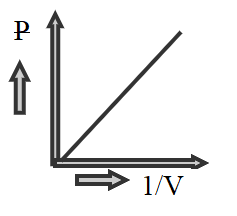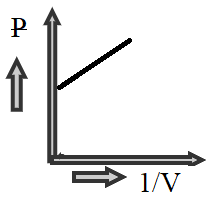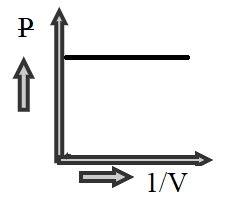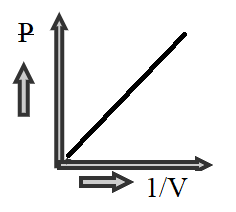
The graph of P vs 1/V at constant temperature is-
A)

B)

C)

D)





Answer
531k+ views
Hint: We know that the fundamental measurements of gases are: volume, temperature and pressure. These terms are interrelated and affect each other. The volume of a given sample of gas depends upon the temperature and pressure applied to it.
Step by step answer: Boyle’s law gives the relationship between P and V by the hyperbola graph at constant temperature. The other two laws are charle’s law which states that at isobaric condition of constant pressure, volume of fixed mass of a gas is proportional to its temperature and gay lussac’s law that states at constant volume, the pressure of fixed mass of gas is directly proportional to the absolute temperature of the gas.
Any change in temperature or pressure will affect the volume of the gas. These relationships which describe the behavior of gases, are called gas laws. The laws are defined as:
Boyle’s law: it states that at constant temperature, the volume of a fixed mass of a gas is inversely proportional to its pressure. Mathematically it can be written as
$
V\alpha 1/P \\
V = K \times 1/P \\
P = K \times 1/V \\
$
Hence we can see that P is directly proportional to 1/V , therefore at constant temperature general term of isotherm plot will be a straight line like in the graph shown below

Hence the correct option is A.
Note: When a gas obeys these laws, it is said to be ideal or perfect gas. These laws are applicable only to gases which do not undergo a change in chemical complexity, when the temperature or pressure is varied.
Step by step answer: Boyle’s law gives the relationship between P and V by the hyperbola graph at constant temperature. The other two laws are charle’s law which states that at isobaric condition of constant pressure, volume of fixed mass of a gas is proportional to its temperature and gay lussac’s law that states at constant volume, the pressure of fixed mass of gas is directly proportional to the absolute temperature of the gas.
Any change in temperature or pressure will affect the volume of the gas. These relationships which describe the behavior of gases, are called gas laws. The laws are defined as:
Boyle’s law: it states that at constant temperature, the volume of a fixed mass of a gas is inversely proportional to its pressure. Mathematically it can be written as
$
V\alpha 1/P \\
V = K \times 1/P \\
P = K \times 1/V \\
$
Hence we can see that P is directly proportional to 1/V , therefore at constant temperature general term of isotherm plot will be a straight line like in the graph shown below

Hence the correct option is A.
Note: When a gas obeys these laws, it is said to be ideal or perfect gas. These laws are applicable only to gases which do not undergo a change in chemical complexity, when the temperature or pressure is varied.
Recently Updated Pages
Master Class 11 Economics: Engaging Questions & Answers for Success

Master Class 11 English: Engaging Questions & Answers for Success

Master Class 11 Social Science: Engaging Questions & Answers for Success

Master Class 11 Biology: Engaging Questions & Answers for Success

Class 11 Question and Answer - Your Ultimate Solutions Guide

Master Class 11 Business Studies: Engaging Questions & Answers for Success

Trending doubts
What is meant by exothermic and endothermic reactions class 11 chemistry CBSE

10 examples of friction in our daily life

One Metric ton is equal to kg A 10000 B 1000 C 100 class 11 physics CBSE

Difference Between Prokaryotic Cells and Eukaryotic Cells

What are Quantum numbers Explain the quantum number class 11 chemistry CBSE

1 Quintal is equal to a 110 kg b 10 kg c 100kg d 1000 class 11 physics CBSE




